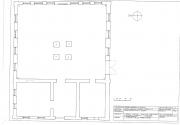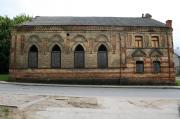Obj. ID: 9136
Jewish Architecture Synagogue in Alytus, Lithuania

The synagogue is situated on the left bank of the river Nemunas in the part of town known as Alytus II.
The synagogue was built in 1911, after a large fire ravaged Alytus II in 1909, in the place of a wooden synagogue that was built as early as 1857.
In the first days of the Nazi occupation, the synagogue was converted into a hospital for prisoners of war, which operated there until the end of August 1941. Later it housed the locksmith workshops of the Alytus Craft School. In the Soviet period, the synagogue served as a salt warehouse, and as the building was adapted for a new purpose, the interior was changed and damaged. In 1992 a renovation project was put forward with the aim of converting the building into an art gallery. However, it has not been implemented. Today (2007) the former synagogue building is out of use and rapidly deteriorating.
The synagogue was erected in so-called “brick-style”, mainly from yellow bricks, using red brick to emphasize the decorative elements. The rectangular building, composed of a prayer hall in the eastern volume and a two-story western volume, is covered with a gable roof of asbestos sheets. The western volume includes a vestibule with two adjacent rooms on the ground floor, and the women’s section on the first floor.
The exterior of the synagogue has remained largely unchanged. Basically, the façades are treated in two ways, indicating the difference between the prayer hall with its fourteen windows and the two-story western volume. Pilasters divide the northern and southern façades into two unequal bays. Similar pilasters emphasize the corners of the building. The northern and the eastern façades facing the street are the most elaborate. Pointed arch windows of the prayer hall are decorated with pointed archivolts and topped with round pediments. Recessed narrow panels in red brick imitating gutters are placed between the arches. The windows are situated above a socle made from stripes of red and yellow brick, which, according to historicist architectural conventions, are elements of oriental design. While the northern façade contains four large windows, the eastern one is designed symmetrically with two groups of three windows and a central blind bay between them. This bay is framed by two slender pilasters rising up to the gable and topped with a small round pediment. Another round pediment matches the interior position of the Torah ark. Above it, the bay is pierced by currently blocked biforia windows, symbolizing the Tablets of the Law, and a central oculus in the apex. The gable sides include two bricked-up semicircular windows adorned with archivolts, as well as two rhombi in red brick on both sides of the biforia. Broader red brick pilasters, decorated by recessed panels in yellow brick, mark the corners of the façade.
On the northern façade, a similar pilaster indicates the division between the prayer hall and the western volume of the building. The western bay of the façade, occupying about one third of its whole length, has two tiers of segment-headed arch windows. To embellish the street façade, the lower windows received triangle pediments, while the upper tier windows are topped with segmental archivolts and interleaved with recessed red brick panels imitating gutters smaller than those in the eastern bay. The whole façade is crowned by a cornice with stepped modillions, and the tiers are separated by a thin stringcourse on the height of the window sills. The red and yellow stripes, which form a socle on the prayer hall façade, are applied to the whole height of the ground floor in the western bay.
The described design scheme is applied to the western façade, too, but while the windows of the ground floor are crowned by straight window cornices, those of the first floor follow the bending of the segmental arches. As on the eastern façade, a pair of lesenes flanks the central bay, dividing the façade into three unequal bays: the northern one with two window axes, the southern one with three, and the central one with the main entrance for men. Likewise, the corner pilasters are different: the northern one has recessed panels like those of the street façade and is crowned by a small “turret”, while the southern pilaster is plain like those on the southern back façade (see below). The entrance in the narrow central bay is framed by a deepened Neo-Romanesque portal with archivolts. The segment-headed window above it is topped by a large brickwork Star of David with red brick background. It is surmounted by currently blocked biforia windows, similar to those on the eastern façade. The central bay is crowned by a small triangular broken pediment with a redbrick field in the middle and a decorative corbel at the apex. The gable sides include two bricked-up semicircular windows adorned with archivolts and red rhombi like on the eastern façade. The doorway on the southern side of the façade was cut through the window during the Soviet period.
The southern, rear façade is the most modest one. Simple lesenes instead of decorated pilasters divide it into western and eastern bays like on the northern façade. The eastern bay, matching the prayer hall, has four pointed windows; the westernmost one and the adjoining pier are cut through by a new gateway. The two-story western bay is now blank but traces of a segment-headed window and a doorway in the first floor are still perceptible. This door served as the entrance for the women and probably was accessed by a wooden staircase attached to the wall, which could explain the absence of windows on the ground floor.
The synagogue represents a comparatively late example of “brick-style” architecture, where occidental motifs – as the Neo-Romanesque portal and the pointed arches – are combined with the oriental motif of colored brickwork stripes.
(Citation from Aliza Cohen-Mushlin, Sergey Kravtsov, Vladimir Levin, Giedrė Mickūnaitė and Jurgita Šiaučiūnaitė-Verbickienė (eds.), Synagogues in Lithuania: A Catalogue. Vilnius: Vilnius Academy of Art Press, 2010. Vol. 1, pp. 90-94).
sub-set tree:
Cohen-Mushlin, Aliza, Sergey Kravtsov, Vladimir Levin, Giedrė Mickūnaitė, Jurgita Šiaučiūnaitė-Verbickienė (eds.), Synagogues in Lithuania. A Catalogue, 2 vols. (Vilnius: VIlnius Academy of Art Press, 2010-12), vol. 1, pp. 87-95..
Valentinas Brandišauskas, "Fate of Jewish Property in Lithuania during World War II," in Alfredas Jomantas (ed.), Jewish Cultural Heritage in Lithuania (Vilnius: Versus aureus, 2006), 20-70, here p. 55..
Marija Rupeikienė, "Synagogues of Lithuania," in Lithuanian Synagogues (Exhibition Catalogue) (Vilnius: The Vilna Gaon Jewish State Museum, 1997) p. 31, ill on p. 34;
Marija Rupeikienė, Nykstantis kultūros paveldas: Lietuvos sinagogų architektūra (Vilnius, 2003), p. 146 ill. 129;
Pinkas hakehilot: Lita, ed. Dov Levin (Jerusalem, 1996) p. 142;
Lite, eds. Mendl Sudarski, Uriyah Katsenelnbogn and I. Kisin (New York, 1951), p. 1479;
www.zydai.lt/lt/content/viewitem/614/;
Niunkaitė-Račiūnnienė, Aistė, Lietuvos žydų tradicinio meno ir simbolių pasaulis: Atvaizdai, vaizdiniai ir tekstai (Vilnius, 2011), iil. 1, 2;
http://jewish-heritage-europe.eu/2017/07/25/lithuania-restoration-of-alytus-synagogue-progresses
https://jewish-heritage-europe.eu/2020/02/28/lithuania-update-alytus-synagogue/





